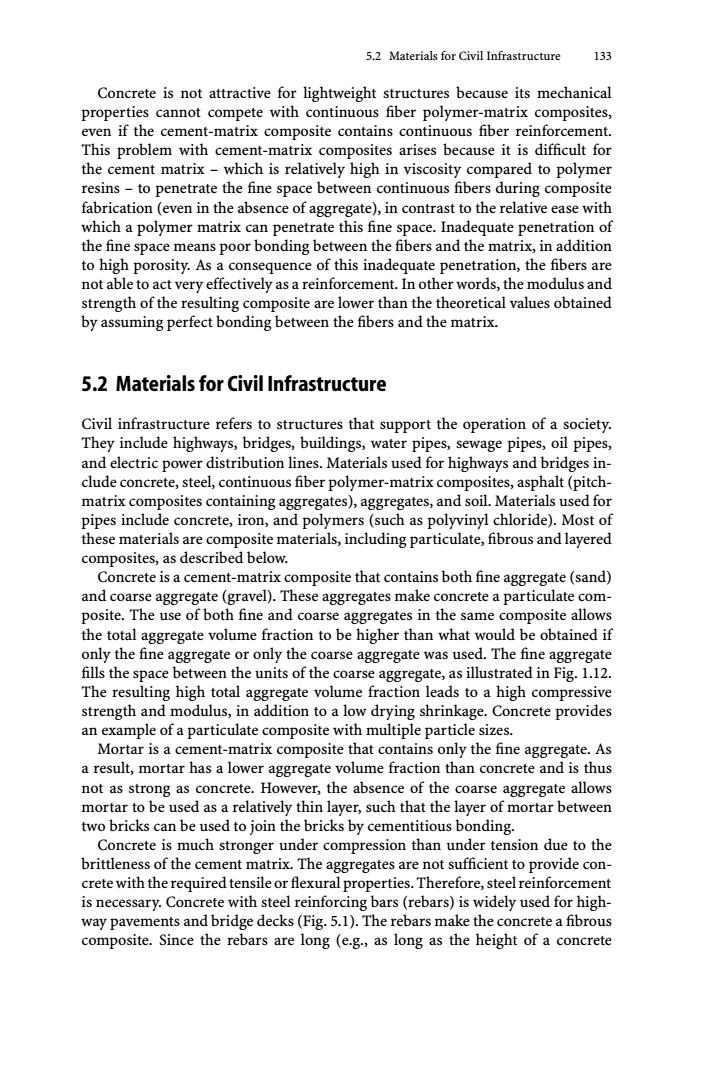正在加载图片...

5.2 Materials for Civil Infrastructure 133 Concrete is not attractive for lightweight structures because its mechanical properties cannot compete with continuous fiber polymer-matrix composites, even if the cement-matrix composite contains continuous fiber reinforcement. This problem with cement-matrix composites arises because it is difficult for the cement matrix-which is relatively high in viscosity compared to polymer resins-to penetrate the fine space between continuous fibers during composite fabrication(even in the absence of aggregate),in contrast to the relative ease with which a polymer matrix can penetrate this fine space.Inadequate penetration of the fine space means poor bonding between the fibers and the matrix,in addition to high porosity.As a consequence of this inadequate penetration,the fibers are not able to act very effectively as a reinforcement.In other words,the modulus and strength of the resulting composite are lower than the theoretical values obtained by assuming perfect bonding between the fibers and the matrix. 5.2 Materials for Civil Infrastructure Civil infrastructure refers to structures that support the operation of a society. They include highways,bridges,buildings,water pipes,sewage pipes,oil pipes, and electric power distribution lines.Materials used for highways and bridges in- clude concrete,steel,continuous fiber polymer-matrix composites,asphalt(pitch- matrix composites containing aggregates),aggregates,and soil.Materials used for pipes include concrete,iron,and polymers(such as polyvinyl chloride).Most of these materials are composite materials,including particulate,fibrous and layered composites,as described below. Concrete is a cement-matrix composite that contains both fine aggregate(sand) and coarse aggregate(gravel).These aggregates make concrete a particulate com- posite.The use of both fine and coarse aggregates in the same composite allows the total aggregate volume fraction to be higher than what would be obtained if only the fine aggregate or only the coarse aggregate was used.The fine aggregate fills the space between the units of the coarse aggregate,as illustrated in Fig.1.12. The resulting high total aggregate volume fraction leads to a high compressive strength and modulus,in addition to a low drying shrinkage.Concrete provides an example of a particulate composite with multiple particle sizes. Mortar is a cement-matrix composite that contains only the fine aggregate.As a result,mortar has a lower aggregate volume fraction than concrete and is thus not as strong as concrete.However,the absence of the coarse aggregate allows mortar to be used as a relatively thin layer,such that the layer of mortar between two bricks can be used to join the bricks by cementitious bonding. Concrete is much stronger under compression than under tension due to the brittleness of the cement matrix.The aggregates are not sufficient to provide con- crete with the required tensile or flexural properties.Therefore,steel reinforcement is necessary.Concrete with steel reinforcing bars(rebars)is widely used for high- way pavements and bridge decks(Fig.5.1).The rebars make the concrete a fibrous composite.Since the rebars are long (e.g.,as long as the height of a concrete5.2 Materials for Civil Infrastructure 133 Concrete is not attractive for lightweight structures because its mechanical properties cannot compete with continuous fiber polymer-matrix composites, even if the cement-matrix composite contains continuous fiber reinforcement. This problem with cement-matrix composites arises because it is difficult for the cement matrix – which is relatively high in viscosity compared to polymer resins – to penetrate the fine space between continuous fibers during composite fabrication (even in the absence of aggregate), in contrast to the relative ease with which a polymer matrix can penetrate this fine space. Inadequate penetration of the fine space means poor bonding between the fibers and the matrix, in addition to high porosity. As a consequence of this inadequate penetration, the fibers are not able to act very effectively as a reinforcement. In other words, the modulus and strength of the resulting composite are lower than the theoretical values obtained by assuming perfect bonding between the fibers and the matrix. 5.2 Materials for Civil Infrastructure Civil infrastructure refers to structures that support the operation of a society. They include highways, bridges, buildings, water pipes, sewage pipes, oil pipes, and electric power distribution lines. Materials used for highways and bridges include concrete, steel, continuous fiber polymer-matrix composites, asphalt (pitchmatrix composites containing aggregates), aggregates, and soil. Materials used for pipes include concrete, iron, and polymers (such as polyvinyl chloride). Most of these materials are composite materials, including particulate, fibrous and layered composites, as described below. Concrete is a cement-matrix composite that contains both fine aggregate (sand) and coarse aggregate (gravel). These aggregates make concrete a particulate composite. The use of both fine and coarse aggregates in the same composite allows the total aggregate volume fraction to be higher than what would be obtained if only the fine aggregate or only the coarse aggregate was used. The fine aggregate fills the space between the units of the coarse aggregate, as illustrated in Fig. 1.12. The resulting high total aggregate volume fraction leads to a high compressive strength and modulus, in addition to a low drying shrinkage. Concrete provides an example of a particulate composite with multiple particle sizes. Mortar is a cement-matrix composite that contains only the fine aggregate. As a result, mortar has a lower aggregate volume fraction than concrete and is thus not as strong as concrete. However, the absence of the coarse aggregate allows mortar to be used as a relatively thin layer, such that the layer of mortar between two bricks can be used to join the bricks by cementitious bonding. Concrete is much stronger under compression than under tension due to the brittleness of the cement matrix. The aggregates are not sufficient to provide concrete with the required tensile or flexural properties. Therefore, steel reinforcement is necessary. Concrete with steel reinforcing bars (rebars) is widely used for highway pavements and bridge decks (Fig. 5.1). The rebars make the concrete a fibrous composite. Since the rebars are long (e.g., as long as the height of a concrete